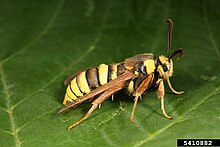Sesia apiformis
| Hornet moth | |
|---|---|
 |
|
 |
|
| Scientific classification | |
| Kingdom: | Animalia |
| Phylum: | Arthropoda |
| Class: | Insecta |
| Order: | Lepidoptera |
| Family: | Sesiidae |
| Genus: | Sesia |
| Species: | S. apiformis |
| Binomial name | |
|
Sesia apiformis (Clerck, 1759) |
|
| Synonyms | |
|
|
The hornet moth or hornet clearwing (Sesia apiformis) is a large bulky moth.
Adults resemble a large hornet - the wingspan is 33–48 mm., the abdomen has yellow banding. After emergence, most of the wing scales are lost revealing the transparent wing membrane.
The hornet moth is a Batesian mimic of, and may be confused with, the real hornet. The moth is as large as a hornet and even has the hornet's rather jerky flight when disturbed, but it has more yellow and lacks the waist between the abdomen and the thorax.
Recorded habitats include parks, hedgerows, golf courses, quarries, pits, fens, plantation edges, pond edges, damp woodland and marshy areas with mature willows. The eggs are laid in old and isolated trees. Trees in open habitats with little vegetation round the base are a particular favourite.
There is one generation each year (univoltine). S. apiformis flies from mid-June to July and sometimes into early August.
The larvae feed on Populus tremula, Populus nigra and Salix caprea.
It overwinters as a larva one and sometimes two times, after which it stays in its cocoon for another winter. Adults are often found on poplar trees straight after emergence. The females lay their eggs at the base of poplar trees, the larval food plant. The larvae hatch and feed mainly just beneath the surface of the bark, near ground or below it. Exit holes can often be seen near the base of poplar trees and there may be pupal cases nearby. The pupal exuvia may also be seen protruding from the exit holes on the trunk of the host tree. Adults are most active in sunshine but are seldom seen. Emergence from the pupa is in early morning and synchronous. Groups of newly emerged moths can be spotted resting on the tree trunk for a few hours before flight.
The hornet moth is a Palearctic species (Europe)
Damage
Larva
Pupa
Adult
Mating
...
Wikipedia
